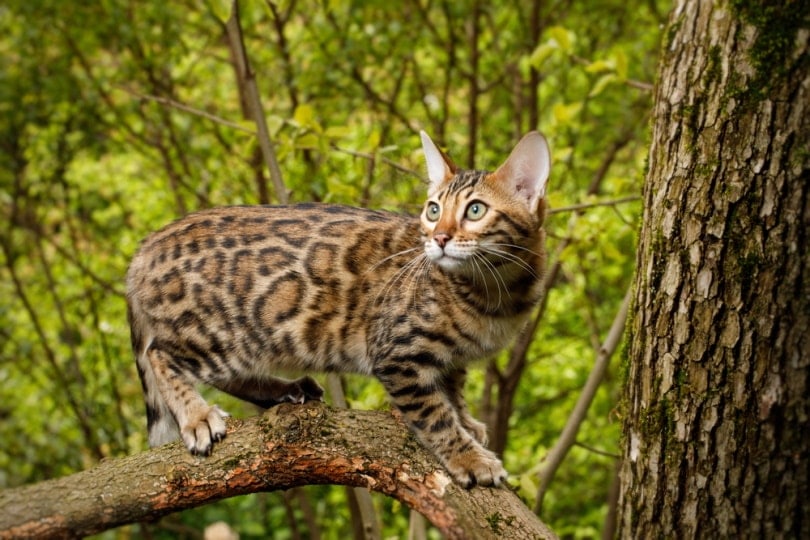How Fast Can a Cat Run? Fascinating Facts & FAQ

Updated on

When your cat lounges on its perch and sleeps the day away, it’s hard to imagine that these animals are athletic and agile predators. Cats can not only jump higher than humans (relative to size) but can outsprint the world’s fastest human runner, which is Usain Bolt, at a speed of 27 miles per hour.
How fast can a cat run? The average healthy housecat can run about 30 miles per hour. This is without stretching or training, which human competitors must do before a race. All it would take to motivate a cat is enticing prey or a threat. Read on to learn more about your fast feline’s running ability!
What Makes a Cat So Fast?
Your fuzzy, lazy housecat has a lot in common with its big-cat counterparts like tigers and cheetahs. Cats are predators, so they must be quick, strong, and flexible to catch prey and outmaneuver predators.
A lot of this capability comes from the fact that cats can rotate their flexible spines more than other animals and twist and contort their bodies as needed. From an idle start, cats can leap up to nine times their height, elongate their spines to narrow their bodies and squeeze through tight spots, and orient themselves in midair to land on all four feet.
This flexibility also helps them sprint. Cats’ spines have elastic cushioning disks that allow them to stretch their spines and increase their speeds. When the cat pushes off the ground to run, the claws provide traction, and the spine extends to propel the cat up to three times the length of its body. In addition, the shoulder blade is attached by only muscles, which allows it to move freely to extend its stride even more.

What’s the Fastest Cat?
As you may have guessed, the fastest cat in the world is also the fastest mammal on record, the cheetah. Adult cheetahs can move at speeds of up to 60 miles per hour and may be able to sprint up to 80 miles per hour over short distances. This is primarily due to the cheetah’s environment, which is primarily grassland and other flat terrains. In fact, many of the animals that evolved over grasslands and plains have fast running speeds.
Other notable wild cats that have high running speeds include the lion, jaguar, leopard, cougar, and tiger. These cats are generally capable of speeds around 50 miles per hour.
The fastest housecat is the Egyptian Mau, a small to medium-sized short-haired cat breed that’s one of the few spotted domestic breeds. It’s also the fastest domestic cat, thanks to its long hind legs and flap of skin on the flank that assists running by increasing its stride length. This breed can reach speeds over 30 miles per hour.
Some other honorable mentions among domestic cat breeds include the Abyssinian, the Somali, the Bengal, the Savannah, and the Manx, all of which are among the most athletic breeds.

How Does the Cat’s Speed Compare to Other Animals?
Cats may be fast, but their running speed pales compared to some of the fastest animals in the world (excluding the cheetah).
| Cheetah | 60 mph |
| Pronghorn antelope | 60 mph |
| Quarter horse | 54 mph |
| Blue Wildebeest | 50 mph |
| Lion | 50 mph |
| Brown hare | 48 mph |
| Greyhound | 46 mph |
| Kangaroo | 44 mph |
| African wild dog | 44 mph |
So, a few animals outperform the domestic cat with running, but both the cheetah and the lion are on the list. If we were to add animals from the sea and air, however, the numbers get much higher.
The peregrine falcon is the fastest bird and reaches flight speeds of up to 186 miles per hour, but when it dives, it can reach speeds exceeding 200 miles per hour. Speeds approaching or exceeding 100 miles per hour aren’t uncommon among raptors.
In the sea, the fastest fish is the sailfish, which has been clocked at speeds over 68 miles per hour. Swordfish, marlin, and other billfish are also capable of incredible speeds. After them, tuna, bonefish, and flying fish are among the fastest fish. Killer whales, or orcas, are also fast for their weight and can reach jumping speeds of 34 miles per hour.

Key Takeaways
Cats are fast and agile predators built to run down prey and evade predators with short bursts of speed. Though the domestic cat may live a comfortable life that doesn’t require this type of athleticism, they still have remarkable agility and fast sprints that can reach up to 30 miles per hour.
Featured Image Credit: Jeannette1980, Pixabay











